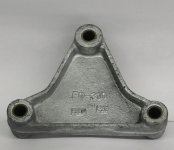I wound up out of town tonight but was able to sketch up a simple pin joint drawing for the level acting blade carrier. Hope it makes sense as I did not have my computer with me and just a paper tablet and ruler to work with.
Thanks.
Yeah ... nope, it makes total sense ... (pictures are always good ... :laughing

If I were to build this I would likely combine the cylinder rod connection with the pin joint pieces in front.
Keep in mind I just woke up, only had 5 hours of sleep, and am still working on the first cup of coffee ... but:
Why ?
Looking to understand the thinking behind it.
It seems to me that doing so would require either: 1. two cylinders (which might not be a bad thing, other than the cost), or 2. a bunch of steel (weight) to make the linkage to make the connection (if only using one cylinder)
What advantage do the triangular pieces with three connection points provide over just the four pieces of barstock you posted in the first picture ?
A good way to do this that would be sturdy would be to use four of the trailer equalizers common on tandem axle trailers. Those triangular equalizers are about the correct size and could utilize the top hole for the cylinder rod.
I'd have to do a bit more searching - and admittedly I just took a quick look at the results from Google - but most of what I found seemed pretty undersized.
All of them had bolt holes of only 9/16" ... which seems way small to me ... and they look like cast metal ...
I don't think I'd want to go with less than 1" pins ... minimum ...
The lower front pin joint could connect to the skid. The lower rear pin joint could connect the adjustable blade carrier.
If you were to swap the lower holes around for the connection to skid and the blade carrier - skid connection in the rear and blade carrier in front - the cylinder would be extending rather than retracting when it was lowered, and would be exerting more force ... although maybe more force would be needed to pull the blades back up out of the ground on the fly once they have dug in and are cutting ... :scratchchin:
The rear pin for the blade carrier joints do not need to connect to the cylinder, so only the lower holes would be used.
Right.
Four identical equalizers would hold the alignment and are relatively cheap to buy.
They also wouldn't be all that hard to make ...
Just some plate or barstock, cold roll solid round for the pins, and some D.O.M tubing or seamless pipe for the pin bushings.
Tack the 4 plates/barstock together, stick 'em in the drill press and punch the holes for the bushings and then weld the bushings in ...
The PITA for me would be doing the holes in the C-channel ... man-handling those up into the drill press mostly.
And doing so would allow some customization, as far as the relationship of the three pivot points in the triangle (or two points if using a simple lever) - which would determine the (amount of) range of motion and/or leverage.
Overall, I like the general concept - obviously, having the blades act in parallel is far more ideal than not ...
Good job ... :thumbsup:



